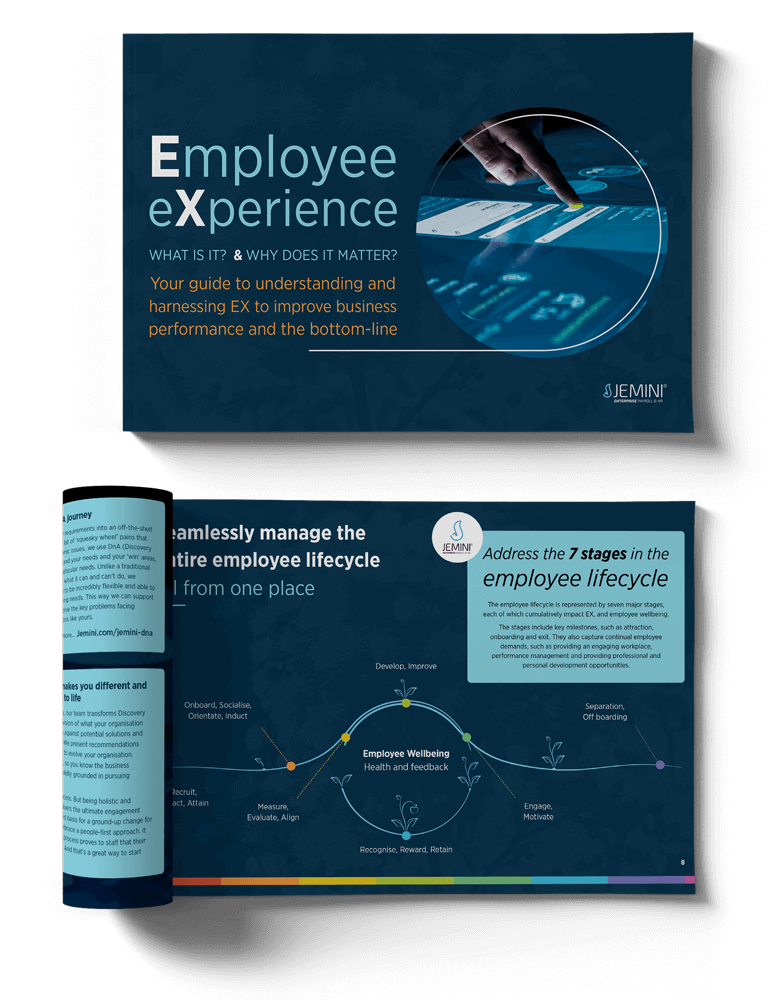If you’ve been reading my recent blogs, it will be no surprise to you that when we designed Jemini’s payroll engine, we focused on the business thinking behind it. As you will have gathered, we’re not big fans of just rejigging traditional processes and making them look pretty.
Why you can’t afford to ignore the financial impact of delivering a poor employee experience
Around this time of year there are a proliferation of blogs and articles on the top trends in technology in reference to finance, HR, ecommerce, life, the future and more. And this year’s no exception.
However, my blog is a bit different. It’s about how failing to take notice of the employee experience (EX) trends can cost you money through employee disengagement, disinterest, and disuse.
And I’m talking bottom-line money. The financials that impact your organisation’s profitability.
A quick recap on what employee experience is
By now we all understand the importance and value of the user experience (UX) and customer experience (CX). So, it’s no surprise that the HR industry took a good look at how championing great UX/CX improves customer engagement and loyalty - and decided to emulate its principles in the workplace.
HR turned UX upside down and introduced EX to replace it – with good reason.
By applying the EX approach in the workplace your HR team can attract new people who are ‘like’ the best of the people already in the business, retain them for longer, and get more value out of their skills and drive while they’re with you. And when they leave, make that a positive experience too (for everyone including the IT department).
EX is the new ‘black’ for organisations who are serious about their people. Why?
The cost of disengagement in the workplace
The bottom-line: Poor employee engagement directly influences your bottom-line.
What it’s costing you: Poor engagement means more sick days, low levels of productivity, higher rates of absenteeism and attrition. Gallup, the renowned American analytics and advisory company, say that only 15% of employees worldwide are fully engaged in their job. This leaves an estimated 85% of your staff (assuming you’re not paying attention to EX) to either actively or subconsciously disengage each day. And Gallup also say that only 12% of organisations are satisfied with their current level of employee engagement.
By comparison: Current figures touted by an assortment of industry experts say that an organisation that offers a higher EX will realise 16% higher profitability, 37% lower absenteeism and 2.5 times higher revenue. You will also reduce staff turnover by 65% and experience an 18% increase in productivity. That’s not to be sneezed at.
The cost of losing and replacing disengaged staff
The bottom-line: Employee turnover and replacement creates economic disruption in a company’s overall productivity and profitability.
What it’s costing you: The Society for Human Resource Management reports that (on average) 36% of new hires fail within the first 18 months, 40% of senior managers hired externally fail within 18 months of being hired. Josh Bersin (Deloitte) says that the total cost of employee turnover can range from tens of thousands of dollars to 150-200% of their annual salary. And Forbes stated that for entry-, mid- and highly skilled-level employees, the associated cost comes to 30-50%, 150%, and 400% of their annual salary respectively. Take your pick from the %s, but when you consider that in the US employee turnover already costs companies $160 billion a year, you start to get the big picture. And it’s scary.
But wait, there’s more: The measurable cost of losing a staff member includes the cost (time/effort and distraction) of sourcing a replacement, hiring, onboarding and training the new person, then ramping them up to peak productivity. Then there’s the ‘final’ pay of the person leaving (along with their 3 months of accumulated leave) and the exit interview.
By comparison: A good EX strategy and the tools you need to make it happen (and I’ll just name drop Jemini here – because I can) will realise strong staff retention and result in higher morale and engagement. Productivity and customer service levels don’t take a nose drive with a constant influx of new staff, and it’s easier to execute business plans as you have a stable work base. How much is that worth to you?
Getting commercial
According to the HR Unity Insights Report (June 2018), only 6% of businesses link their HR measures with business metrics. Very few have moved to future-orientated analytics, despite the fact that a future-proofed business is a stronger commercial model than one subject to disruption.
I guess that shouldn’t be a surprise when you consider that only 24% of businesses measure the commercial impact of their People/Culture initiatives. And 75% of organisations are still trying to define what EX means to them.
Admittedly, it’s harder to connect HR outcomes to commercials than say, Marketing and Sales. However, 60% of the HR leaders surveyed in Unity’s report said that ‘improving the employee experience is expected to result in greater customer experience, revenue growth and operational efficiency.’ As far as this leadership group goes, the employee engagement dataset is the most highly valued prize.
While EX is in its infancy (as mentioned earlier, it is a relatively new concept), research shows that it is expected to play a far more concrete role in the future. The report says that 48% of executive teams already have EX on their radar, and rate it as ‘important’ and a further 10% deem it ‘business critical’. And like most opportunities, those who act fast will realise more commercial value and mileage.
So, what do I think?
After reading this, I’m guessing the question you probably have at this point probably isn’t ‘how much can I save’. But given the impact that an EX strategy can have, how do I save it?
Simple. Look to the future, now.
Put EX at the top of the list when looking for that new HR/Payroll solution. You’re looking for features that:
-
Increase engagement: Choose something that mimics real life with apps, chat and people-centric collaboration tools. Enable peer-to-peer feedback and reviews. Allow pay-on-demand.
-
Improve usability: Look for a solution that’s a pleasure to use, so people use it! Think intuitive, innovative, friendly and engaging. And with single login so it’s easily accessible.
-
Automate tasks: Select AI and ML enabled software to streamline iterative, time-consuming people management tasks
-
Equip HR to succeed: Opt for a solution that provides the EX to help you meet your commercial goals and makes available data that helps your HR team shape your business culture.
And then call me.
Resources:
- Employee Turnover Source: Altman, J. “How Much Does Employee Turnover Really Cost?” Huffington Post. Jan 19, 2017
- 2018 HR Unity Insights Report. “HR loves change”
Explore more
Share this page
Ready to transform your HR & Payroll process?





